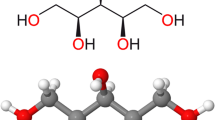Abstract
Objectives: To evaluate effects of natural and artificial honey solutions on urinary nitrite content, prostaglandin excretion and urinary variables in healthy individuals.
Methods: The study comprised 12 individuals, nine males and three females; age range 25–45 years. Urinary total nitrite, prostaglandin E2 (PGE2), prostaglandin F2 α (PGF2 α) and thromboxane B2 (TXB2) were assessed in spot morning sample and 1, 2, and 3 hours after ingestion of 80 g of natural honey dissolved in 250 ml water. Honey solution was given at night; urine volume, urinary osmolality and electrolytes, and serum osmolality and electrolytes, were assayed 10 hours after drinking honey. Same procedure was repeated after drinking artificial honey (30 g glucose plus 38 g fructose) and compared with control (drinking 250 ml of water).
Results: The mean (SD) of total urinary nitrite excretion was 103 ± 43.5 umol/l which was increased by 40%, 55% and 74% at 1, 2, and 3 hours after drinking honey solution respectively. The mean urinary PGE2 was 1.323 ± 0.8 ng/ml that was decreased by 31% 3 hours after honey ingestion. The mean urinary PGF2 α was 1.554 ± 1.2 ng/ml and that of TXB2 was 0.35 ± 0.4 ng/ml. Forty-four percent reductions in urinary PGF2 α and 67% reduction in TXB2 were obtained 3 hours after drinking honey. Honey increased insignificantly free water clearance, filtered sodium and creatinine clearance. It decreased insignificantly urinary osmolality, urinary calcium, urinary sodium, and fasting blood sugar (FBS). Little changes were obtained in urine volume and urinary urea, glucose and creatinine concentration. Artificial honey decreased urinary nitrite and increased urinary prostaglandins concentration. It increased insignificantly free water clearance, filtered sodium, urinary urea, urinary creatinine and creatinine clearance. It decreased insignificantly urinary osmolality, urinary calcium, urinary sodium, and fractional excretion of sodium (FENa). Artificial honey increased FBS by 14% and urinary glucose by 76.5%, and decreased serum sodium and plasma osmolality.
Conclusion: Honey solution decreased urinary prostaglandins concentration and increased total urinary nitrite content whilst artificial honey decreased urinary nitrite and increased urinary prostaglandins.
Similar content being viewed by others
References
A Zaghloul H El-Shattawy A. Kassem (2001) ArticleTitleHoney, a prospective antibiotic: extraction, formulation, and stability Pharmazie 56 643–647 Occurrence Handle11534343
N. Al-Waili (2003) ArticleTitleTopical application of natural honey, beeswax and olive oil mixture for atopic dermatitis and psoriasis: partially controlled, single-blinded study Complement Ther Med 11 226–234 Occurrence Handle10.1016/S0965-2299(03)00120-1 Occurrence Handle15022655
N Al-Waili (2003) ArticleTitleIntravenous and intrapulmonary administration of honey solution to healthy sheep: effects on blood sugar, renal and liver function tests, bone marrow function, lipid profile, and carbon tetrachloride-induced liver injury J Med Food 6 231–247 Occurrence Handle10.1089/10966200360716652 Occurrence Handle14585190
N. Al-Waili (2003) ArticleTitleGlycaemic response to glucose and honey in patients with diabetes mellitus The FASEB J 17 272
N. Al-Waili (2003) ArticleTitleIntrapulmonary administration of natural honey solution, hyperosmolar dextrose or hypoosmolar distill water on normal individuals and to patients with type-2 diabetes mellitus or hypertension Eur J Med Re 8 295–304
N. Al-Waili (2003) ArticleTitleEffects of daily consumption of honey solution on haemtological indices and blood levels of minerals and enzymes levels in normal individuals J Med Food 6 135–140 Occurrence Handle10.1089/109662003322233549 Occurrence Handle12935325
Al-Waili (2004) ArticleTitleNatural honey lowers plasma glucose, C-reactive protein, Homocycteine and blood lipids in healthy, diabetics or hyperlipidaemic subjects: comparison with dextrose and sucrose J Med Food 7 100–107 Occurrence Handle10.1089/109662004322984789 Occurrence Handle15117561
N Al-Waili N. Boni (2003) ArticleTitleNatural honey lowers plasma prostaglandins in healthy individuals J Med Food 6 129–134 Occurrence Handle10.1089/109662003322233530 Occurrence Handle12935324
N Al-Waili N. Boni (2003) ArticleTitleEffects of honey ingestion on nitric oxide in saliva The FASEB J 17 246
N. Al-Waili (2003) ArticleTitleIdentification of nitric oxide metabolites in various honeys and effects of honey on plasma and urinary nitrite/nitrate concentration J Med Food 6 359–364 Occurrence Handle10.1089/109662003772519921 Occurrence Handle14977445
T Noonan O. Banks (1999) ArticleTitleThe role of nitric oxide in saline – induced natriuresis in rats Proceeding Soc Exp Biol Med 221 376–381 Occurrence Handle10.1046/j.1525-1373.1999.d01-95.x
H Garcia I Pomposiella L. Govin (1996) ArticleTitleNitric oxide inhibits ADH – stimulation osmotic water permeability in cortical collecting ducts Am J Physiol 270 F206–F210 Occurrence Handle8769841
L Herbert R Jacobson D Fredin D. Breyer (1993) ArticleTitleEvidences that separate PGE2 receptors modulate water and sodium transport in rabbit cortical collecting duct Am J Physiol 265 F643–F652 Occurrence Handle8238544
N. Al-Waili (2002) ArticleTitleIncreased nitrite urinary excretion in patients with primary enuresis: effects of indomethacin treatment on urinary and serum osmolality and electrolytes, urinary volumes and nitrite excretion Brit J Urol Int 9 254–262
Al-Waili N. Urinary nitrite excretion and urinary variables in patients with primary frequency of micturition and normal subjects: effects of indomethacin suppositories. Worl J Urol 2004 (in press).
D. Holmlund (1983) ArticleTitleThe pathophysiology of ureteric colic Scand J Urol and Nephrol 75 IssueIDSuppl 25–27
T Niwa K Maeda M. Shibata (1987) ArticleTitleUrinary prostaglandins and thromboxane in patients with chronic glomerulonephritis Nephron 46 281–287 Occurrence Handle3627322
M Nakano T Hidaka R Ogura et al. (1988) ArticleTitleIncreased platelet thromboxane synthesis in renal glomerular disease Prostagl Leukot Essent Fatty Acids 31 113–116
L Purkerson J Joist J Yates A Veldes A. Morrison (1985) ArticleTitleInhibition of thromboxane synthesis ameliorates the progressive kidney diseases of rats with subtotal renal ablation Proceed Nat Academy of Sci USA 82 193–197
F Cosentino M Eto P Paolis ParticleDe B. Loo Particlevan der (2003) ArticleTitleHigh glucose causes up regulation of cycloxygenase-2 and alters prostanoid profil human endothelial cells: role of protein kinase C and reactive oxygen species Circulation 107 1017–1023 Occurrence Handle10.1161/01.CIR.0000051367.92927.07 Occurrence Handle12600916
Author information
Authors and Affiliations
Corresponding author
Rights and permissions
About this article
Cite this article
Al-Waili, N.S. Effects of Honey on the Urinary Total Nitrite and Prostaglandins Concentration. Int Urol Nephrol 37, 107–111 (2005). https://doi.org/10.1007/s11255-004-0871-8
Issue Date:
DOI: https://doi.org/10.1007/s11255-004-0871-8




